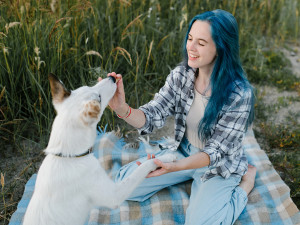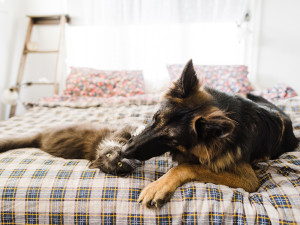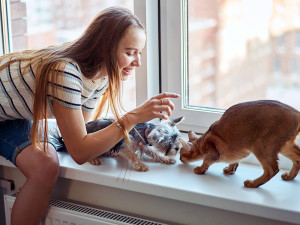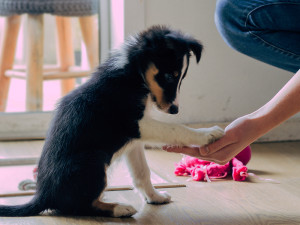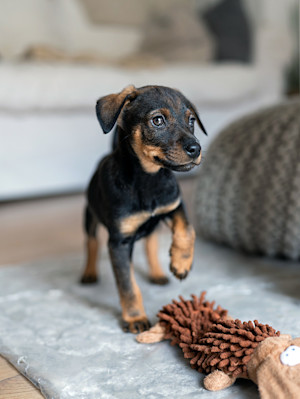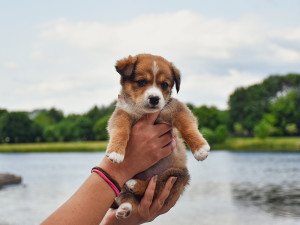How to Introduce a Puppy to a Cat
Yes, there is a way to make this transition smooth.

Share Article
In This Article:
Understanding the Nature of Dogs and Catsopens in a new tab Preparing for the Introductionopens in a new tab How to Introduce a Puppy to a Catopens in a new tab How to Manage Introduction Issuesopens in a new tab
Did you know that more than half of all United States households have a pet, with many sharing their home with cats and dogs? Yet, introducing these two famously feisty species can feel like refereeing a wrestling match.
Will the cat claim their throne as the ruler of the house, or will the puppy with boundless energy win the day? Will the pair become best friends, or will they remain mortal enemies?

littleKin™ is Kinship’s home just for puppy and kitten parents. Bop over to check out expert advice, new pet tools, and special deals—all curated for your newest family member.
opens in a new tabMain takeaways
Introducing a puppy to a cat requires patience and preparation, as these species have unique natures and instincts.
Cats are territorial and value solitude, while puppies are energetic and curious, necessitating a careful approach to introductions.
Assessing the temperaments of both pets is crucial for a successful introduction, as some personalities may clash more than others.
Creating a safe and controlled environment, including separate spaces and elevated cat areas, helps ease the transition.
Gradual steps such as scent swapping, visual contact, and supervised interactions are effective strategies for fostering positive associations between puppies and cats.
Introducing a new dog into a cat’s domainopens in a new tab is like setting up a blind date between an extreme introvert and an extrovert. These species are opposites, and cats are renowned for being territorial. In contrast, puppies are energetic, curious, and sometimes clueless. So introducing these two takes patience and preparation.
Read on to learn how to introduce a puppy to a cat in your household. But also keep in mind that harmony is the end goal, but civility is what you’ll settle for — at least for now.
Understanding the nature of dogs and cats
Cats and dogs are as different as night and day. While their personalities are unique to each pet, their overall natures, instincts, and behaviors are ingrained as a species.
For instance, cats are territorial, often valuing space, quiet, solitude, and routine. Their body language is subtle, like a flicking tail that indicates irritation or a slow blink to express affection. Puppies, on the other hand, are balls of energetic enthusiasm, especially when young. They barrel into new situations with wagging tails and boundless curiosity.
This dynamic can create confusion and frustration when your new puppy’s eagerness is met with your cat’s “stay away” glare. The good news is that cats and dogs aren’t doomed to misunderstand each other forever. You can bridge the gapopens in a new tab between these feline and canine personalities with guidance and patience.
Preparing for the introduction
Before you bring these two pets together, you’ll need to do some prep work. A little effort from the get-go can ensure a smoother meeting process.
Assessing the temperament of your cat and puppy
Start by evaluating your cat’s and pup’s personalities. For example, is your cat confident or skittish? Are they quick to swipe, growl, hiss, or run away when faced with something (or someone) new? Is your puppy playful or laidback? Do they bound from one thing to another, sniffing and snuffling recklessly? Or do they love napping and begging for belly rubs?
Some personalities clash more than others. A shy cat may need extra time and space, while a rambunctious pup may need more training to curb excessive excitement. Knowing their temperaments will help you predict potential challenges and outcomes, and allow you to tailor your approach to make sure your pets are comfortable during this process.
Creating a safe environment
A clean, comfortable, well-prepared home is essential for a smooth introduction. Designate separate spaces for your cat and puppy which contain their food, water, toys, and bedding. Use baby gates or a strategically placed crate to establish boundaries, giving each pet time to adjust to new smells, sounds, and sights.
Your cat should have access to elevated areas, like shelves or cat trees, where they can observe the puppy safely. Cats need time to acclimate, especially if your pup is already bigger and more rambunctious than your cat can handle. Elevation gives them an escape route if they feel overwhelmed.
Create separate spaces: Provide your cat with a quiet room containing their bed, toys, and litter box. Set up a crate for your puppy to give them a secure, cozy area.
Add elevated areas for your cat: Install shelves or get a cat tree so they can observe everything from a safe height. These areas should be entirely out of the puppy’s reach.
Use baby gates to maintain boundaries: Baby gates can separate rooms or areas of the house, allowing your pets to see and smell each other without direct contact.
Avoid resource guarding: Keep food, water bowls, and toys separate to prevent territorial disputes.
Allow gradual exploration: Let cats and dogs explore shared spaces (living room, kitchen, etc.) one at a time to get accustomed to each other’s scent without pressure.
How to gradually introduce your puppy to your cat
Introducing a new puppy to your household cat can feel like introducing a tornado into a peaceful oasis. However, with patience and a step-by-step approach, you can tame this whirlwind before it becomes an issue. The goal is to create positive associations and peaceful interactions, reducing the risk of aggression or misunderstandings between your cat and pup.
Here are a few tips to help your pets transition from wary acquaintances to comfortable companions who can peacefully share a home.
1. Scent swap
Cats and dogs have high-powered noses and use scent markers to make a space theirs. Start by swapping scents between pets. Place a blanket or toy from your puppy in your cat’s space, and vice versa. This allows each animal to familiarize themselves with the other’s scent in a non-threatening way and at their own pace.
2. Allow the animals to explore the other animal’s area on their own
Let your cat and puppy explore each other’s spaces separately. This helps them acclimate to each other’s presence without direct contact. Keep doors closed, or use a baby gate to create a safe barrier.
3. Visual contact
Have both pets become comfortable with each other’s scent and overall presence? Introduce them visually. Keep your puppy leashed, and let your cat approach at their own pace. Watch for aggressive body language, like raised fur, hissing, or growling from either animal. A relaxed cat will have soft ears, while a calm puppy will wag their tail.
4. Supervised contact while leashed
Allow them to be in the same room together while your puppy is leashed. Sit down, create a safe, calm space with your presence, and let them interact. Offer treats to both pets to develop positive associations with peaceful, friendly behavior.
5. Supervised contact with the puppy off-leash
You can allow supervised, off-leash interactions once your cat and puppy are comfortable. Keep sessions short and monitor their behavior. If either pet becomes stressed or aggravated, separate them immediately and try again later.
The goal is for interaction to become a nonissue, where you no longer have to worry about aggressive or anxious behaviors.
How to manage introduction issues
Even the best-laid plans can have challenges when introducing a puppy to a cat. Cats and dogs communicate differently, and mismatched body language can lead to growls, hisses, loud barks, and chasing around the house. While these moments are stressful, they’re manageable.
With patience and strategic planning, you can address common introduction issues and set the stage for peaceful coexistence. Check out these examples of common problems and how to address them.
The puppy won’t stop chasing the cat.
Puppies are naturally curious and playful, so your cat’s movements may trigger their instinct to chase. Training is essential. To prevent chasing, teach your puppy commands like “stay” or “leave it.” Redirect their energy with plenty of mental stimulation and exercise. Ensure that your cat has access to elevated areas or safe rooms where your pup can’t reach them.
The cat is aggressive toward your puppy.
Cats often act out of fear or territoriality. Your cat may show aggression or hostility with hisses, swats, or avoidance. Respect your cat’s space by ensuring a safe zone where the pup is not allowed. Go back to scent swapping to reintroduce your puppy to your cat gradually. Reward your cat with praise and treats to create positive associations and reinforce calm behavior.
The puppy ignores boundaries.
Puppies may not understand that cats value personal space. Use a leash to control interactions, keeping your puppy from being too pushy. If the puppy continues pestering your cat, calmly remove them from the situation to signal that their behavior is unacceptable.
Both pets seem stressed.
Introducing a new puppy to a cat can be overwhelming for both pets, especially if the cat is older or if either pet was adopted from a shelter. You never know the extent of trauma in an adopted pet’s past.
According to Pam Johnson Bennettopens in a new tab, a certified cat behaviorist with more than 50 years of experience and expertise, you should “move at the pace of the most stressed-out pet and remember that nothing matters more than keeping everyone safe.” Slow down the process. There’s no rush. Repeat earlier steps, such as swapping scents and leashed interactions, to give both pets time to adjust. Offer soothing toys and treats to calm anxiety. If issues persist, consult a veterinarian or animal behaviorist for advice.
FAQs
How long will it take for a cat to get used to a new puppy?
The time it takes for a cat to get used to a new puppy varies, but typically ranges from a few days to a few months. This depends on the cat’s temperament and the puppy’s behavior. Confident cats may warm up quickly, while shy ones may need more time to acclimate to a new puppy’s energy and presence. The key is to move gradually and respect your cat’s comfort level. Avoid rushing the process.
How will a cat accept a new puppy?
Cats accept new puppies more easily and readily when introductions are gradual, and their routines remain consistent. Starting with scent swapping and slow, supervised interactions can help ease this transition. Providing your cat with safe spaces and elevated areas ensures they feel secure and less threatened.
How do I get my cat to bond with my puppy?
Creating a bond between your cat and puppy involves calm, positive experiences where both pets feel safe, loved, and rewarded. Use treats, praise, and positive reinforcement to encourage peaceful behavior. Some cats may take longer to warm up to dogs, so give your cat plenty of patience and space. Never rush direct interactions.
References
“American Kennel Club.” American Kennel Club, 2017, www.akc.org/press-center/articles-resources/facts-and-stats/cats-dogs-togetheropens in a new tab.
“How to Introduce a Dog and Cat.” Animal Humane Society, www.animalhumanesociety.org/resource/how-introduce-dog-and-catopens in a new tab.
Johnson-Bennett, Pam. “Pam’s Story.” Pam Johnson-Bennett Answers the Why, When & How of Cat Behavior Issues, 20 Jan. 2010, catbehaviorassociates.com/pams-storyopens in a new tab.
“Making Friends: Introduction & Socialization Tips.” Aspcapetinsurance.com, 2015, www.aspcapetinsurance.com/resources/making-friends-introduction-socialization-tips.

Valerie Mellema
Valerie Mellema has a Bachelor of Science in Agribusiness and Equine Industry from West Texas A&M University. She has been a professional writer for the past 20 years, covering a wide variety of pet health and care topics before founding a nonprofit focused on mental health in children and thoroughbred aftercare. She has four Border Collies and eight retired racehorses.
Related articles
![Woman playing with her cat and dog.]() opens in a new tab
opens in a new tabHow to Introduce a Cat to a Dog
Hint: Take it slow.
![Border Collie puppy shaking owner's hand]() opens in a new tab
opens in a new tabWhen to Start Training a Puppy: a Complete Puppy Training Schedule By Age
Your puppy training schedule, from eight weeks to six months. Let’s do this.
![Puppy playing at home with his toy alone.]() opens in a new tab
opens in a new tabTips for Leaving Your Puppy Home Alone for the First Time
![Two hands holding a very young tan and white puppy up in front of a lake landscape]()
How to Socialize a Puppy
Everything you need to know to get your new addition off to a good start.
